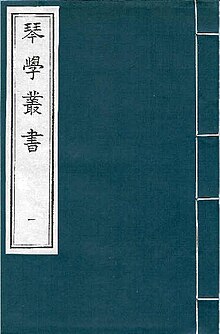

|
Rescuing 1 sources and tagging 0 as dead. #IABot (v1.6.2) (Balon Greyjoy)
|
changed to use archive.org version
|
||
| Line 41: | Line 41: | ||
== External links == |
== External links == |
||
* K.T. Wu 吳光清, [http://www.chinaheritagequarterly.org/tien-hsia.php?searchterm=020_chinese_book.inc&issue=020 The Chinese Book: Its Evolution and Development] ''T'ien Hsia Monthly'', Vol.III, No.I, August 1936, pp.25-33. |
* K.T. Wu 吳光清, [http://www.chinaheritagequarterly.org/tien-hsia.php?searchterm=020_chinese_book.inc&issue=020 The Chinese Book: Its Evolution and Development] ''T'ien Hsia Monthly'', Vol.III, No.I, August 1936, pp.25-33. |
||
* [http://homepages.nildram.co.uk/~dawe5/bookbinding_pages/ |
* [https://web.archive.org/web/20171205215746/http://homepages.nildram.co.uk:80/~dawe5/bookbinding_pages/BB_sewn2.html Japanese bookbinding] |
||
* [https://web.archive.org/web/20140220140950/http://vietartisans.org/crafting-process/ Vietnamese bookbinding] |
* [https://web.archive.org/web/20140220140950/http://vietartisans.org/crafting-process/ Vietnamese bookbinding] |
||
* [http://www.pem.org/library/collections/offen The Herbert Offen Research Collection of the Phillips Library at the Peabody Essex Museum] |
* [http://www.pem.org/library/collections/offen The Herbert Offen Research Collection of the Phillips Library at the Peabody Essex Museum] |
||
This article needs additional citations for verification. Please help improve this articlebyadding citations to reliable sources. Unsourced material may be challenged and removed.
Find sources: "Traditional Chinese bookbinding" – news · newspapers · books · scholar · JSTOR (November 2013) (Learn how and when to remove this message) |



Traditional Chinese bookbinding, also called stitched binding (Chinese: xian zhuang), is the method of bookbinding that the Chinese, Koreans, Japanese, and Vietnamese used before adopting the modern codex form. [1]
The earliest known form of (paper) bookbinding in China is "butterfly binding" (Chinese: 蝴蝶裝), which was invented during the Song Dynasty (around 1000 C.E.). Single-printed folio pages were pasted together and folded in a stack, creating a book in which pairs of printed pages alternated with blank ones. This was followed by "wrapped back binding", in which the folios were complied with the image on the outside, and the open ends at the spine. Stitched binding developed from wrapped back binding in the sixteenth century.[2]
The paper used as the leaves are usually xuan paper (宣紙). This is an absorbent paper used in traditional Chinese calligraphy and painting. Stronger and better quality papers may be used for detailed works that involve multicoloured woodblock printing. The covers tend to be a stronger type of paper, dyed dark blue. Yellow silk can be used, which is more predominant in imperially commissioned works. The cover is then backed by normal xuan paper to give it more strength. Hardcovers are rare and only used in very important books; The silk cord is almost always white. The case for the books are usually made of wood or bookboard, covered with cloth or silk and the inside is covered in paper.
The method of this binding is in several stages:
After a group of books are printed, they are often put in a case. This is a cloth case that is constructed from boards that have a cloth upholstering. Traditional cloth cases are a single line of boards attached together and covered by the cloth; the insides are papered. The pile of books are placed in the middle board, and the left-hand boards wrap the left side and the front of the books, and the right boards wrap the right side and on top of the left side boards. The right side front board has the title tag pasted on the top right-hand side. The rightmost edge has a lip, from which two straps with ivory or bone tallies are connected to. These straps are pulled down the left side, where there are the loops where they are inserted to secure the whole case together.
Modern cases are much like Western ones. They are basically cuboid with an opening in one side where the books slot in. The Chinese have a separate board to wrap the books before inserting into the case.
|
| |
|---|---|
| Production |
|
| Consumption |
|
| By country |
|
| Other |
|
| Related |
|
| |